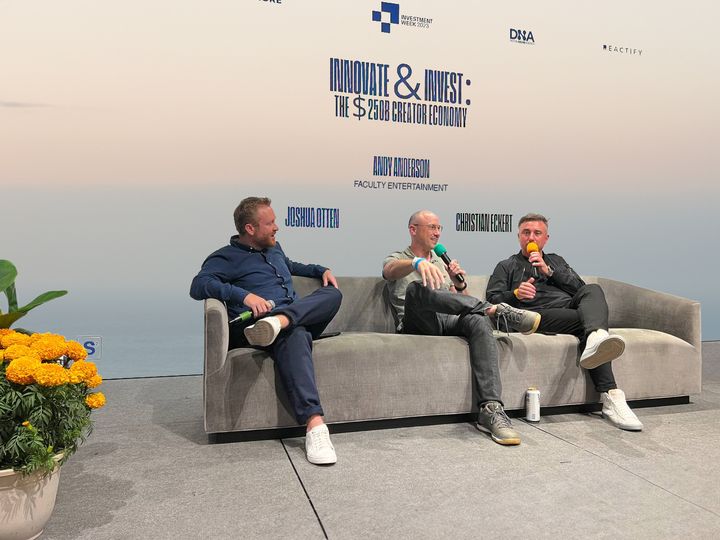Andy Anderson and Tom Porricelli Share Insights on Emerging Technology and the Future of AI

The Emerging Technology ‘Conversation with the Experts’ section is produced by the L.A. Times B2B Publishing team in conjunction with Citrin Cooperman and Faculty Entertainment.
The world of high-tech applications for business and personal use – ranging from new hardware and software innovations, AI, cloud computing, digital media and gaming – has become a true power industry that overlaps with virtually every other business sector and has become vastly different from how it was even just five years ago. New developments in technology and communications have built up a strong infrastructure for making dynamic changes in every area.
As public demand for “the latest and greatest” services and products grow, an increasing number of consumers, businesses and investors are deepening their relationships in and around the sector. As with any booming industry, especially with a polarizing and complex technology such as AI, learning about the ins and outs of the diverse and fast-growing space can be overwhelming.
To take a closer look at the latest developing trends in the business of new tech, we have turned to two of the region’s leading authorities who graciously weighed in for a discussion and shared insights.
Q: What are the hottest trends in emerging technology today?

Tom Porricelli, Partner, Technology Practice, Citrin Cooperman: The pace of change in the technology sector has always been swift and continues to evolve every day. Some of the most prominent trends in the current landscape relate to artificial intelligence, the Internet of Things (IoT) and cybersecurity/privacy. AI continues to provide a high-risk, high-reward solution as a disruptor utilizing predictive capabilities to solve problems that previously required substantial resources. More and more organizations are becoming receptive to AI as a solution to their potential problems, much like when software created efficiencies during the digital revolution. Also, the continued development and expansion of IoT devices are evident. These devices, including Google Home, Amazon Alexa, Ring doorbells, smartwatches, and many more, have become integral parts of daily life, and the list continues to grow and evolve as the world becomes ever more connected. However, with increasing connectivity – every app downloaded, smart device used and social media post made – individuals are expanding their digital footprint and leaving themselves vulnerable to having their data compromised, so there is a trend among organizations to find ways to secure individuals’ data and privacy.

Andy Anderson, Managing Director, Faculty Entertainment, Partner, Faculty Group: From my vantage point, I’ve observed how blockchain and AI are empowering the creator and experience economies, fundamentally altering the entertainment landscape. This is particularly the case in Los Angeles, where tech companies secured an impressive $5.1 billion in funding, underscoring the city’s burgeoning tech prowess. In our industry, talent is central to fans’ experiences. Emerging technologies present novel avenues for consumers to engage with their favorite artists and athletes. I’m particularly intrigued by avatars in shared worlds and on-chain fan loyalty programs. Furthermore, spatial computing, especially in sports arenas, is enhancing the experience economy. These aren’t fleeting trends; they represent a foundational shift in entertainment.
Organizations must identify the specific problems that they want AI to solve by establishing clear, measurable goals for smoother AI implementation.
— Tom Porricelli
Q: What are some of the biggest mistakes that organizations make today when it comes to emerging technology?
Porricelli: Over the last few years, many organizations have faced unprecedented uncertainty, leaving their leaders under increasing pressure to innovate, modernize and drive efficiency to keep up with the pace of change and support the organization’s future. These leaders are looking for solutions to streamline, optimize and automate processes in order to create efficiencies and improve their bottom line. Unfortunately, all too often, organizations fall short or encounter a wide range of challenges when implementing emerging technologies. The most frequent shortcomings typically originate from the lack of a well-defined strategy or implementation plan for the product, resulting in wasted resources. A frequent byproduct of not having a well-defined plan tends to be inadequate training, which creates further inefficiencies. However, the largest challenge organizations encounter is the resistance to change. As a society, individuals tend to be creatures of habit and are not always ready to embrace change. Organizations that proactively address these issues are consistently in a better position to leverage the advantages of adopting emerging technologies while mitigating the associated risks and challenges.
Anderson: Throughout my journey, I’ve identified a common pitfall among emerging tech entities: an overwhelming emphasis on the technical aspects rather than the user experience. Consider email: its widespread adoption isn’t due to a public understanding of its backend mechanics but its seamless integration into our lives. In contrast, many blockchain endeavors get bogged down in the nitty-gritty of NFTs and decentralized networks. What enterprises truly seek are technologies that address challenges and elevate user experiences. AI, as showcased by platforms like Midjourney and ChatGPT, excels in prioritizing user experience. Blockchain initiatives would do well to emulate this approach, emphasizing the experience over the intricate tech.
The pace of change in the technology sector has always been swift and continues to evolve every day.
— Tom Porricelli
Q: Artificial intelligence is transforming the way businesses operate by automating processes, predicting outcomes and providing personalized experiences. What steps should businesses be taking to ease their way into AI use?
Porricelli: Artificial intelligence is an evolving journey of learning and improvement. The key is to start with a clearly defined objective in order to build a solid foundation and gradually expand organizations’ capabilities as they gain more experience and confidence. Organizations must identify the specific problems that they want AI to solve by establishing clear, measurable goals for smoother AI implementation. Once these issues have been pinpointed, organizations should evaluate the various AI tools that best align with their current abilities. A pivotal next step is investing in training to create the necessary framework of internal expertise and advocates. Just as with any new initiative, resistance to change is common but having a guiding presence to assist employees and enhance the customer experience will be essential for long-term success in using AI.
Q: Do you think we’ve hit the ‘Internet of Things’ ceiling or do you foresee further spread of connectivity into realms that haven’t yet gotten there?
Anderson: We’ve only scratched the surface of the ‘Internet of Things.’ The ‘Connected Mobility Experience Economy’ narrative suggests boundless opportunities for IoT. I anticipate a fusion of entertainment, shopping, education and daily tasks, facilitated by wearables, voice and gesture-based technologies. Projections suggest a staggering $626.5-billion market by 2030 for these interconnected experiences. As vehicles tap into advanced 5G and 6G networks connecting 900 million new devices (vehicles) online and autonomous driving becomes prevalent, passengers will increasingly work, shop, game and consume content during commutes. We’re on the precipice of a transformative era, where our daily engagements will be amplified by a vast interconnected device network, heralding integrated, immersive experiences.
Porricelli: As artificial intelligence and machine learning technology continue to evolve, the Internet of Things will also progress. This will lead to enhanced user experience through innovations in hardware, software, security and connectivity. Smart devices have become an essential part of our daily lives, whether in homes, in vehicles or in the workplace, fostering increased connectivity. The application of IoT is expanding in sectors such as healthcare and agriculture, where trigger sensor technology helps patients and improves the efficiency of growing and producing crops. According to Cisco, approximately 500 billion devices are expected to be connected to the internet by 2030, signifying substantial growth potential as long as technology continues to evolve.
We’re on the precipice of a transformative era, where our daily engagements will be amplified by a vast interconnected device network, heralding integrated, immersive experiences.
— Andy Anderson
Q: How have the digital media demographics shifted in the last 10 years?
Anderson: Over the past decade, the digital media landscape has shifted profoundly. Young consumers, especially Gen Z, show a marked preference for online interactions – over 60%. While some label this as ‘dystopian,’ it’s an avenue rife with opportunity. Brands, recognizing this, are tailoring their offerings to a digitally-inclined audience. Moreover, digital educational tools and enhanced retention rates exemplify the benefits of this shift. It’s imperative, however, to maintain a balance between digital and real-world engagements. This isn’t a transient phase; it signifies a deep-seated change in societal preferences.
Q: From your perspective, what’s the next big trend in AI and machine learning?
Porricelli: The next big trend in artificial intelligence is applied AI. As technology becomes more sophisticated, it will become applied further to solve specific, real-world problems or create AI-driven products or systems. This can include recommendation systems used in e-commerce platforms, fraud detection for financial institutions and the ability to predict medical diagnoses.
Young consumers, especially Gen Z, show a marked preference for online interactions – over 60%.
— Andy Anderson
Q: What industries and business sectors are benefiting most from leveraging blockchain?
Anderson: In recent times, numerous sectors have tapped into blockchain’s potential, but its most transformative influence is evident in entertainment, especially fandom. Historically, artists juggled multiple third-party platforms for ticketing, streaming and merchandising, often losing touch with devoted fans. Blockchain is rectifying this. Artists, utilizing blockchain solutions, can now track and reward fan engagement across platforms. This ensures fans feel acknowledged, while artists and stakeholders benefit from deeper engagement and increased revenue. It’s a symbiotic relationship, heralding a new era in entertainment.
“Citrin Cooperman” is the brand under which Citrin Cooperman & Company, LLP, a licensed independent CPA firm, and Citrin Cooperman Advisors LLC serve clients’ business needs. The two firms operate as separate legal entities in an alternative practice structure. Citrin Cooperman is an independent member of Moore North America, which is itself a regional member of Moore Global Network Limited (MGNL).
The original article is from the LA Times.


